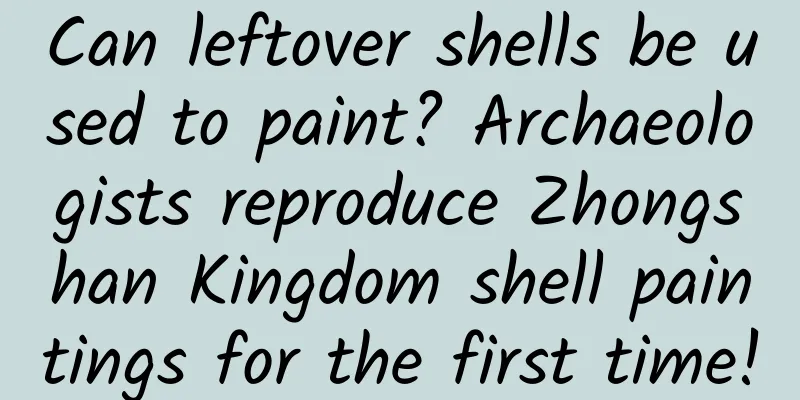Can leftover shells be used to paint? Archaeologists reproduce Zhongshan Kingdom shell paintings for the first time!

|
In ancient times, in addition to being used as food, decorations, production tools, religious props, and trading currency, our ancestors also used shells as a medium for painting, but archaeological evidence in this regard is relatively rare and related research is quite lacking. Recently, Chinese scholars have used scientific and technological means to make up for the lack of research in this archaeological field. For the first time, they have successfully restored the shell painting images from the Zhongshan Kingdom site during the Warring States Period more than 2,000 years ago and achieved a series of important research results. How to successfully rebuild and recover Professor Luo Wugan's team from the Department of Archaeology and Anthropology, School of Humanities, University of Chinese Academy of Sciences (UCAS) said that the paper on the achievement, which was jointly completed by them and their colleagues from the School of History and Culture of Chifeng University of Inner Mongolia, the Department of Archaeology and Museology, School of History of Renmin University of China, and the Hebei Provincial Institute of Cultural Relics and Archaeology, was recently published in the top international journal in the field of cultural heritage protection, "Cultural Heritage Journal", tracing the history of this unique art form of shell painting back to at least the Warring States Period in China. According to Chen Dian, the first author of the paper and a special research assistant in the Department of Archaeology and Anthropology of the School of Humanities of the University of Science and Technology of China, the shell paintings of the Zhongshan Kingdom (414-296 BC) during the Warring States Period unearthed in Qinglian Village, Lingshou County, Hebei Province, were severely damaged due to the burial environment. Despite this, the research team conducted a series of advanced scientific and technological means and methods to conduct detailed research and successfully reconstructed and restored the shell paintings of the Zhongshan Kingdom, and clearly answered questions about its pigments, craftsmanship and other related issues. Based on morphological characteristics, the shells used in these two shell paintings are clearly classified as clams of the genus Meretrix in the family Ceratidae. They mainly inhabit the intertidal and subtidal zones along the coast of China and have been highly valued since ancient times for their unique medicinal and culinary value. Based on the discovery of many pairs of perforated shells in other tombs of the Zhongshan Kingdom, it is inferred that the two shells are most likely from the same individual. In addition, a rouge clam box was unearthed from the Chu Tomb in Baoshan, Hubei, which is quite similar in appearance to these pairs of shells. Observation through a 3D video microscope shows that the production of Zhongshan shell paintings begins with the use of convex lines to carefully outline and position the image. Its craftsmanship is reminiscent of similar methods widely used in jade carving. It is undoubtedly a huge challenge to complete such a complex and exquisite craftsmanship on such a small and fragile shell. The difficulty is beyond imagination. Among them, in sharp contrast to the raised outline, some areas of the shell surface are more concave. This concave and convex effect, coupled with the superposition of layers of pigments and the naturally curved surface of the shell, allows the painting to show intricate details according to the change of the observer's perspective. Then, by combining X-ray fluorescence and Raman spectroscopy, the research team conducted in-depth testing and analysis, and finally determined the various pigment components used in the Zhongshan Kingdom shell painting: red pigment, whose bright and rich color comes from cinnabar; green pigment, whose fresh and natural tone is given by malachite; black pigment, whose deep and mysterious color is due to the use of carbon black. In addition, traces of red pigment can still be seen on the outer side of the shell, but it is severely covered by mud and difficult to distinguish. The selection of these pigments not only reflects the ancient craftsmen's precise grasp of color, but also demonstrates their superb skills in the use of materials. In order to prevent other pigments from being missed, the research team also used multispectral imaging technology to carefully capture the color details in the painting, and successfully identified 6 characteristic curves in different color ranges. In addition to the curves corresponding to the aforementioned colors, two curves were found that were closely related to soil attachments showing different tones. The research team speculated that these pigments may contain some kind of adhesive to ensure that the pigments can adhere tightly to the shells, and subsequent research will further reveal this. In view of the significant obstacle posed by mud deposits on the shells to image reconstruction, the research team used industrial computed tomography (CT), a non-invasive method, to carefully explore the internal structure of the samples, collect spatial distribution data of different substances, and combine them with identifiable contour lines to successfully reconstruct these two precious shell paintings from more than 2,000 years ago. What are the important findings from the comparative study of shell paintings? Professor Luo Wugan, the corresponding author of the paper, pointed out that among the many uses of shells, it is quite rare to use the inner wall of shells as a base for painting, and there are not many examples of shell paintings. For example, shells with monochrome figures painted on them dating from 700 to 1500 AD were discovered in Kimalco, Collier County, USA. Due to the lack of archaeological background information, the details of the origin, creation date and authenticity of the two shell paintings collected by the Cleveland Museum of Art in the United States cannot be verified, resulting in limited academic attention to them. In China, three groups of shell paintings unearthed from the M32 cemetery south of Xujia Village in Linzi, Shandong, made a stunning appearance. Compared with the shell paintings unearthed from the Zhongshan Kingdom, the two showed certain similarities in style and production process. The research team conducted a comparative study and found that the three groups of shell paintings in Linzi, Shandong were carefully placed on the north side of the lacquer box outside the coffin, which obviously carried special symbolic meanings; the shell paintings of Zhongshan Kingdom were only placed between the feet of the tomb owner. This simple placement may reflect different funeral concepts and the cultural beliefs they contain. The team further observed that the identity, status, and quantity and quality of the tomb owner's burial objects also showed a sharp contrast. Many precious bronze, gold, jade and other objects were unearthed in the Linzi M32 tomb. Its luxurious burial objects undoubtedly demonstrated the extraordinary identity and status of the tomb owner. In comparison, the tomb owner of Lingshou Qinglian shell painting seemed ordinary, with very few burial objects. Combining two shell paintings in the collection of the Cleveland Museum of Art in the United States, the research team summarized some significant similarities in the shell paintings discovered so far: first, all shell paintings show consistency in craftsmanship, and all adopt a bas-relief technique called "reduced ground"; second, the shells used for painting are of the same type and similar size, which is enough to show that the shell materials are carefully selected; finally, the production of shell paintings may follow a standardized procedural framework to ensure the uniformity and standardization of the works. In addition, in terms of subject matter, shell paintings mainly focus on scenes of people participating in various activities, which are often closely linked to aristocratic status or ritual significance, fully demonstrating the social outlook and cultural connotations of the time. In terms of pigment use, red pigment is used on the faces and skin of the characters in shell paintings, and its color selection reflects, to some extent, the aesthetic concepts and cultural traditions of the society at that time. What is the significance of shell painting archaeological research? Zhang Wenjing, co-first author of the paper and associate professor of Chifeng University, said that in general, the shell paintings unearthed in Linzi and the shell paintings of Zhongshan State belong to the same era, and the similarities between the two are quite significant. In contrast, the shell paintings collected by the Cleveland Museum of Art in the United States show more delicate and full brushstrokes, revealing a more mature artistic style, perhaps suggesting that they were completed in a later period. The scientific and archaeological research on shell paintings also shows that this unique art form seems to have been extremely popular in northern China during the Warring States Period, and its influence was far-reaching and continued until the Han Dynasty. These shell paintings not only have unique carriers, but also rich and diverse themes, lifelike character portrayals, and mature and sophisticated composition, so they have extremely high historical, scientific and artistic value. Paper co-author Wang Xiaokun, associate professor at Renmin University of China, said that as one of the early examples of a globally popular art form, shell paintings undoubtedly deserve in-depth comparative studies with related art materials such as lacquer paintings, silk paintings, bronze and jade carvings, so as to further reveal their unique artistic charm and cultural connotations. In addition, the research team also conducted in-depth and detailed research on many aspects of the shell paintings of the Zhongshan Kingdom, speculating that the trees in the paintings may be tung trees. At the same time, this shell painting archaeological research also explored the potential connection between the headdresses and clothing of the characters in the paintings and other unearthed cultural relics of the Zhongshan Kingdom, further revealing the historical and cultural information behind these cultural relics. In response to the suggestion by some scholars that the ancients believed that the unique shape of shells symbolized fertility and creativity, could preserve and prolong the existence of the soul and prevent the body from decaying, and that according to the theory of the Five Elements and certain myths and legends, shells also had the function of guiding the soul of the tomb owner through the River Styx to the realm of eternal life, Luo Wugan emphasized that based on current research, these views are still vague and unclear, and he looks forward to the discovery of more archaeological relics and related research in the future, which will fully reveal the profound significance of shells in burial culture. |
>>: Will 2023 be the hottest summer in the past 2,000 years? | Environmental News
Recommend
What are the functions of Lanzhou WeChat Moving Mini Program? How much does it cost to develop a mini program for a moving company?
As the pace of social development continues to acc...
Bao Fan talks about entrepreneurship: Opening up the key points of entrepreneurship from the perspective of investment banks
Bao Fan, founder and CEO of China Renaissance Cap...
5 factors that influence the price quotes of bloggers on Xiaohongshu
I have talked to you about the topic of monetizat...
Information flow promotion optimization strategy, do this well to achieve 80% success!
Seeing the world through our eyes is an innate ab...
Tips for writing short videos about drama
Nowadays, short videos have become one of the mai...
Dalian will conduct nucleic acid testing on 190,000 people, and the sudden local confirmed cases have attracted attention!
Chinanews.com, Dalian, July 23 (Reporter Yang Yi)...
What should I pay attention to when renting a server?
What should I pay attention to when renting a ser...
up to date! Tips for maintaining an account on Xiaohongshu!
Often, our friends will give us feedback on these...
If you choose autumn clothes like this, you might as well not wear them at all? Learn about the "three-layer dressing rule"
When I was little, my mother liked to buy me this...
How did Facebook get to 2 billion users? The answer is "science" and "empathy"
Yesterday afternoon, Zuckerberg said more than 65...
The only way to program is to be slow
There is still a big difference in programming sp...
The goldfish has been wronged for so long, will it really eat to death?
Goldfish don’t die from being “overfed”, they die...
iOS 15 vs. iOS 14: You’ll regret it after upgrading!
iOS 15 is currently in the 8th version of testing...
What are the channels for publishing articles for free in soft-text marketing?
Soft content marketing is the most common and eff...
The igloo is made of snow, but it can be used to make fire and keep warm. How did the Inuit do it?
The words "ice" and "snow" ar...









